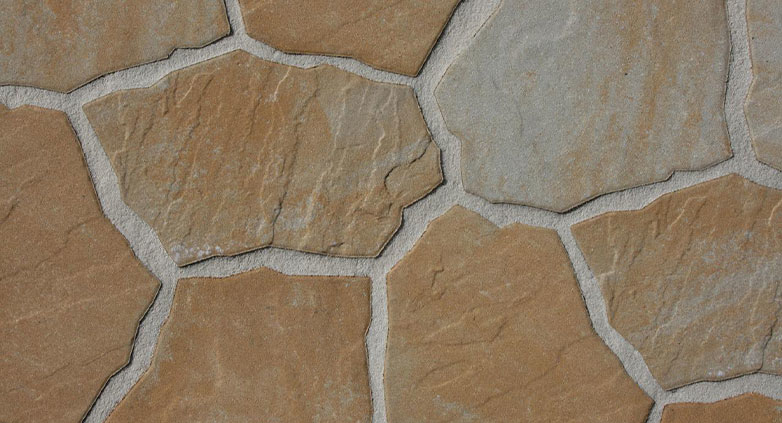Sandstone Paving – A Guide For Your Patios and Driveways
Sandstone paving is a unique and aesthetically-pleasing way to enhance your patios and driveways. Of course, with so many different types of paving stones available, how can you know if sandstone is the right choice for you?
Sandstone is easy to install, simple to maintain, more sustainable than concrete, and looks great for tons of different applications, making it one of the most popular choices for driveways and patios.
Come with us as we discuss the ins and outs of sandstone paving so you can determine whether or not it is the right choice for you.
What Is Sandstone?
Sandstone is an ultra-common sedimentary rock that consists of clasts (or grains of materials, organic matters, and sand) that is anywhere from 0.06 to 2mm.
People classify different forms of sandstone by clasts. There are three different grains that these clasts are typically divided into, including:
| grain type | clast size |
|---|---|
| Fine-grains | 0.06 to 0.2mm |
| Mid-grains | 0.2 to 0.6mm |
| Coarse-grains | 0.6 to 2mm |
There are also different categories that we divide our sandstone into based on their mineral composition:
- Lithic Grains – These grains are made from sedimentary, metamorphic, and igneous rocks.
- Feldspar Grains – These grains are made from Plagioclase feldspar or alkali.
- Quartz Grains – These grains are predominantly made from quartz minerals and have the longest capacities of the bunch.
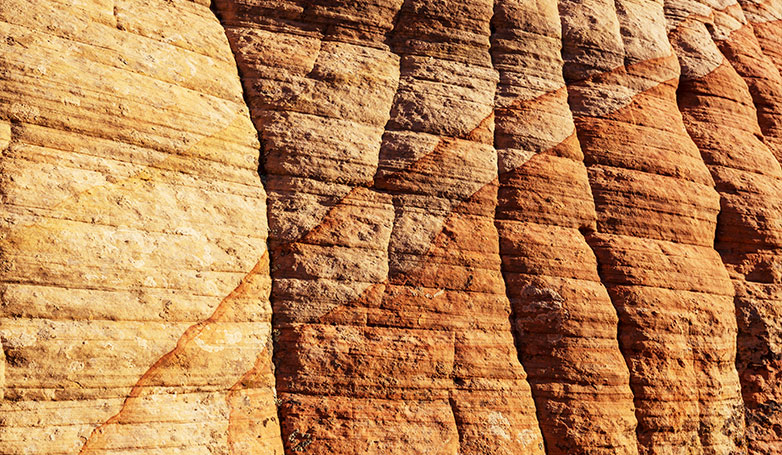
More Like This:
Is Sandstone Good For Paving?
There are plenty of different types of natural stone that are great for paving, though people often use sandstone for exterior applications.
So, why is this?
Let’s look at a few reasons why so many homeowners are using sandstone for their outdoor paving applications.
Aesthetically Pleasing
Sandstone comes in a wide range of hues and colors, allowing you to find one that fits in with your surroundings with ease. Each piece of sandstone is adorned with natural beauty. Whether you want a bit of contrast or cohesion with the surrounding area, sandstone allows for it.
You’ll find various grains and veins in different patterns and densities in the natural world.
Great In Wet Areas
Sandstone is a porous stone, meaning it’s not the best option for areas that get wet often. However, if you seal your sandstone or give it a proper chemical treatment, you can use it around a swimming pool and enjoy a beautiful, non-slip surface.
Sandstone comes with anti-skid properties thanks to its slightly rough texture, perfect for those who want a sturdier wet surface.
Easy To Maintain
If you use proper surface treatments or sealants, it is easy to clean your sandstone. To wash away dirt, dust, and mild staining, you can use something as simple as plain water or a mild washing detergent.
The beauty of sandstone compared to concrete is that it is composed of individual tiles or blocks, not a single, large entity.
So, for example, if one of the tiles or blocks gets damaged, you can rip up the damaged piece without messing up the rest of the floor. Plus, it’s often very easy to match pieces, so you don’t have to have an eye sore in your outdoor space.
Great For Stepping Stones
Because sandstone is durable, hard, and weather-resistant, it is a great choice for stepping stones in your landscape design. You can even decide to put your sandstone in highly trafficked areas without any worry.
Sustainable and Renewable
Compared to concrete, sandstone is far more sustainable and environmentally friendly. Of course, there are a few additional manufacturing costs associated with shaping, packaging, and transporting sandstone, though if you’re looking to minimize your carbon footprint while beautifying your backyard, sandstone is one of the best choices around.
Check out our sandstone vs. limestone paving guide for an in-depth comparison.
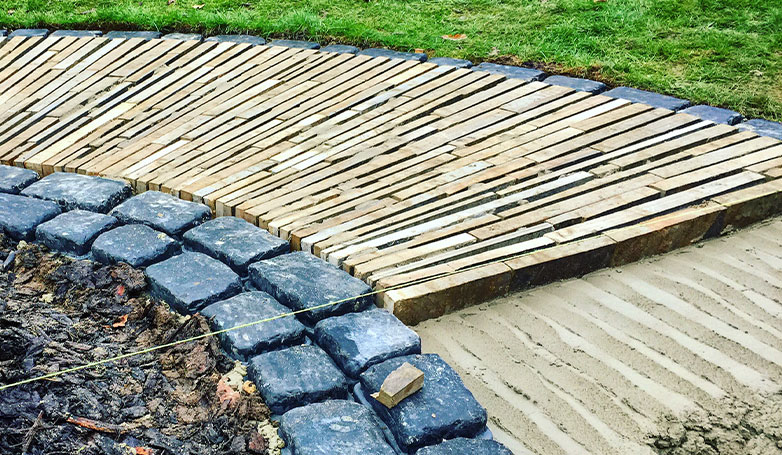
Related Articles:
Sandstone Paving In Driveways
Sandstone is great for driveways, as it is one of the most durable natural stones around. People will often use sandstone to build block pavers. Beyond the fact that sandstone looks great, it is very strong, allowing for heavy load-bearing.
Sandstone Paving In Patios
People often use sandstone paving in patios, thanks to the fact that they offer tons of flexibility during the installation process. You can makeover your patio in any way you deem fit using any kind of sandstone that works for you.
One of the great things about sandstone is that it is ultra-malleable, allowing you to make intricate designs for your patio in your garden or backyard. You can also find sandstone that works with your budget, as there are many tiers of this wonderful material out there.
Homeowners will often have their sandstone treated to make it glossy or semi-glossy. On the other hand, you might want a more natural look by maintaining the uneven and porous texture that your sandstone naturally comes with.
It’s difficult to find this type of natural look anywhere else!
Are Sandstone Patios Expensive?
Thanks to the fact that sandstone is a natural stone material, it is one of the least expensive paving options out there. On average, you will pay anywhere between $10 to $20 per square foot for your sandstone.
Check out our article, How Much Does It Cost To Pave A Driveway, for more in-depth information on the costs you can expect.
Different Types of Sandstone Paving
1. Riven Sandstone Paving
One of the best styles of sandstone paving for adding a rustic, textured feel to your space is riven sandstone paving.
With riven sandstone paving, you get individual pieces of sandstone that range in terms of thickness. It’s very important that you lay these pieces of sandstone down carefully to make them properly aligned and stable.
2. Calibrated Sandstone Paving
If you want to keep the thickness of your stones as consistent as possible, we highly recommend going with calibrated stone paving. This type of paving is very popular because it is the most uniform. Calibrated stone paving makes for a far more uniform cut. These stones are much easier to transport and lay down.
You’ll find that these types of slabs are 22mm in thickness, though the thickness can change if they are cut by hand.
3. Sawn Sandstone Paving
Sawn sandstone paving, sometimes referred to as honed sandstone paving, will go through several unique processes to give you a modern aesthetic.
These stones are cut using machines down to the nearest millimeter. The stones are then buffed, giving you the smoothest finish possible. If you’re working on a modern landscaping project, we highly recommend sawn sandstone paving.
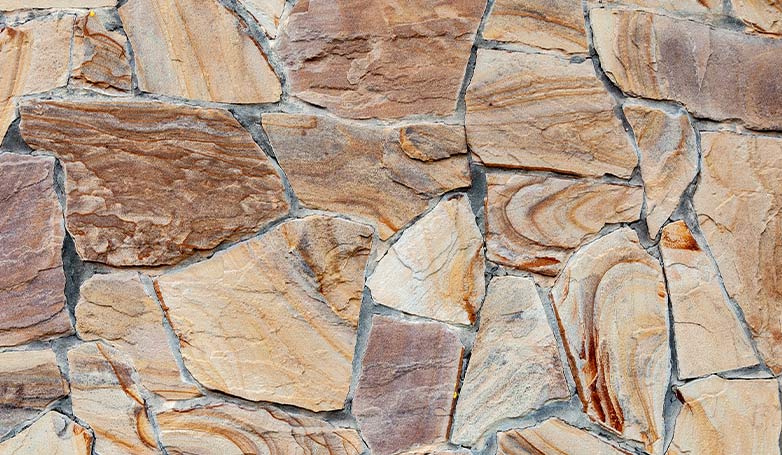
See More:
- Best 20 Driveway Lights
- Driveway Paving Cost Calculator
- Sloping Driveway Drainage Solutions
- Macadam Driveway
How Long Does Sandstone Paving Last?
One of the great things about sandstone is that it can last for many years if you take care of it, which is one of the reasons it has become so popular for outdoor applications. They don’t break very easily, allowing you to handle them effectively without worry.
All you have to do is wipe or spray them down every now and then to make sure they stay shiny and clean. Compared to other types of natural stones, sandstone is one of the most reliable stones out there.
Using Indian sandstone or rainbow sandstone and high-quality sealant, you can expect your sandstone to last anywhere from 30 to 50 years. On the other hand, if you use cheap quality materials and don’t take care of your sandstone, you can end up having to replace them in 2 to 10 years.
Do You Need To Seal Sandstone Paving?
Unless there is a good reason for sealing your sandstone paving, we would not recommend it. We often see people botch their sealant jobs, ruining the natural look of the stone. Unfortunately, restoring your stone after you have already sealed it is impossible. You need to make sure that applying sealant is something you actually want to do.
If you live in a place with inclement weather, including extreme heat, rain, or snow, sealing your sandstone paving can help protect it so that it lasts longer. It’s important to choose a sealer that suits the color of your sandstone and that you’re careful when reading your sealing directions.
If you use a high-quality sealant, you should only need to reapply it every three years or so.
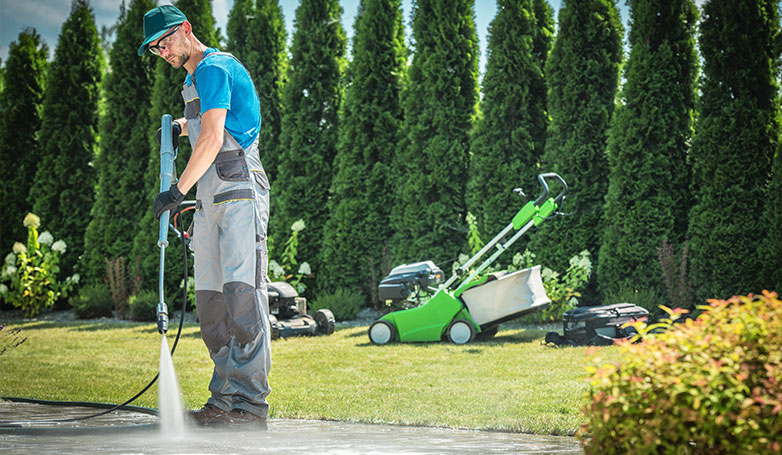
Related Articles:
- How To Clean Brick Patio
- How To Paint Concrete Patio
- How To Clean Concrete Patio
- How to Drain Asphalt Driveway Puddles
Can You Pressure Wash Sandstone Paving?
Because sandstone paving is naturally resistant to chemicals and erosion, it is one of the best for resisting pressure washing. You don’t have to worry about pressure washing damaging your sandstone material.
However, if your stones weren’t laid correctly or are placed too close together, you might notice sudden dislodgement or movement when you spray them with high-pressure water.
The good thing is that you won’t have to pressure wash very often, as sandstone does not stain very easily. Oils and moisture in the sandstone will eventually stain if you leave them sitting there for long periods, though if you’re diligent about cleaning and wiping your sandstone down, you shouldn’t have to worry about this.
We recommend using a high-quality sealant to block out extraneous moisture.
Final Thoughts
As you can see, sandstone is one of the best options for outdoor applications, all thanks to its versatility, reliability, and ease of use. If you want to beautify your house with natural colors or create a safe, non-slip outdoor space, we highly recommend looking into using sandstone for your next project.

